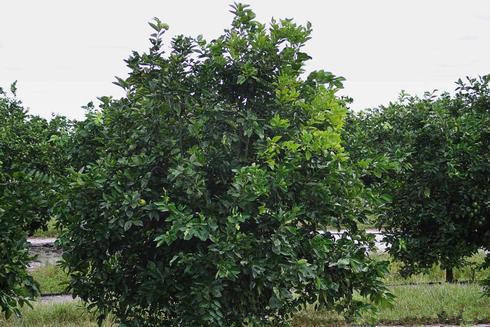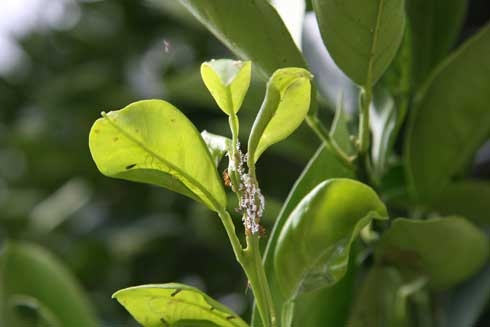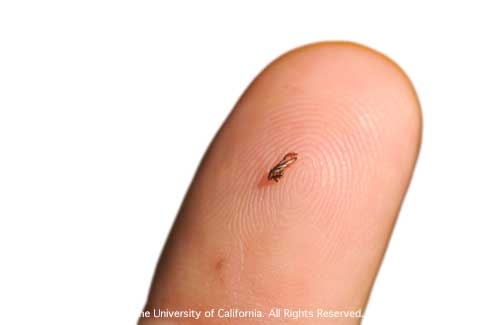
Alert from CDFA Plant Health and Prevention Services
The California Department of Food and Agriculture (CDFA) and the United States Department of Agriculture (USDA) have established a 94-square mile quarantine in portions of Riverside and San Bernardino counties following the detection of the citrus disease huanglongbing (HLB), or citrus greening. HLB is a deadly disease of citrus plants and closely related species, and can be transmitted from tree to tree by the Asian citrus psyllid.
On July 15, HLB was discovered in a grapefruit tree in the city of Riverside in a residential neighborhood near the intersection of Chicago and Marlborough avenues. A month later, on August 28, state and federal officials confirmed the find of a second tree infected with HLB on a neighboring property just behind the initial find.
The quarantine boundaries are on the north, Interstate 10; on the east, Box Springs Mountain Reserve; on the west, Riverside Municipal Airport; and on the south, East Alessandro Boulevard. HLB quarantine maps for Riverside and San Bernardino counties are available online at:www.cdfa.ca.gov/plant/pe/InteriorExclusion/hlb_quarantine.html. Please check this link for future quarantine expansions in these counties, should they occur. Quarantines are already in place for HLB in portions of Los Angeles and Orange counties.
The quarantine will prohibit the movement of all citrus nursery stock out of the area, while maintaining existing provisions allowing the movement of only commercially cleaned and packed citrus fruit. Any fruit that is not commercially cleaned and packed, including residential citrus, must not be removed from the property on which it is grown, although it may be processed and/or consumed on the premises.

Residents are urged to take several steps to help protect citrus trees:
- Do not move citrus plants, leaves or foliage into or out of the quarantine area, or across state or international borders. Keep it local.
- Cooperate with agricultural crews placing traps, inspecting trees and treating for the pest.
- If you no longer wish to care for your citrus tree, consider removing it so it does not become a host to the pest and disease.
CDFA crews have already removed the infected tree and are in the midst of a treatment program for citrus trees to knock down Asian citrus psyllid infestations within 800 meters of the find site. By taking these steps, a critical reservoir of the disease and its vectors will be removed, which is essential to protect the surrounding citrus from this deadly disease.
HLB is a bacterial disease that attacks the vascular system of plants. It does not pose a threat to humans or animals. The Asian citrus psyllid can spread the bacteria as the pest feeds on citrus trees and other plants. Once a tree is infected, there is no cure; it typically declines and dies within a few years.
CDFA, in partnership with the USDA, local county agricultural commissioners and the citrus industry, continues to pursue a strategy of controlling the spread of the Asian citrus psyllids while researchers work to find a cure for the disease.
To identify the Asian citrus psyllid and the disease symptoms of HLB, see the fact sheets, videos in English and Spanish and other resources at http://ucanr.edu/acp.
If you see any trees that display symptoms of huanglongbing, contact your local agriculture commissioner.
To learn about the latest research, visit UC ANR's new Science for Citrus Health website at http://ucanr.edu/sites/scienceforcitrushealth.
More resources on Asian citrus psyllids and huanglongbing:
- Science for Citrus Health http://ucanr.edu/sites/scienceforcitrushealth
- ACP/HLB Distribution and Management http://ucanr.edu/acp
- UC IPM Pest Note http://ipm.ucanr.edu/PMG/PESTNOTES/pn74155.html
- Newest Detection of Citrus Greening (HLB) is in Riverside //ucanr.edu/blogs/blogcore/postdetail.cfm?postnum=24776
- UC has boots on the ground in an unrelenting search for Asian citrus psyllid //ucanr.edu/blogs/blogcore/postdetail.cfm?postnum=24752